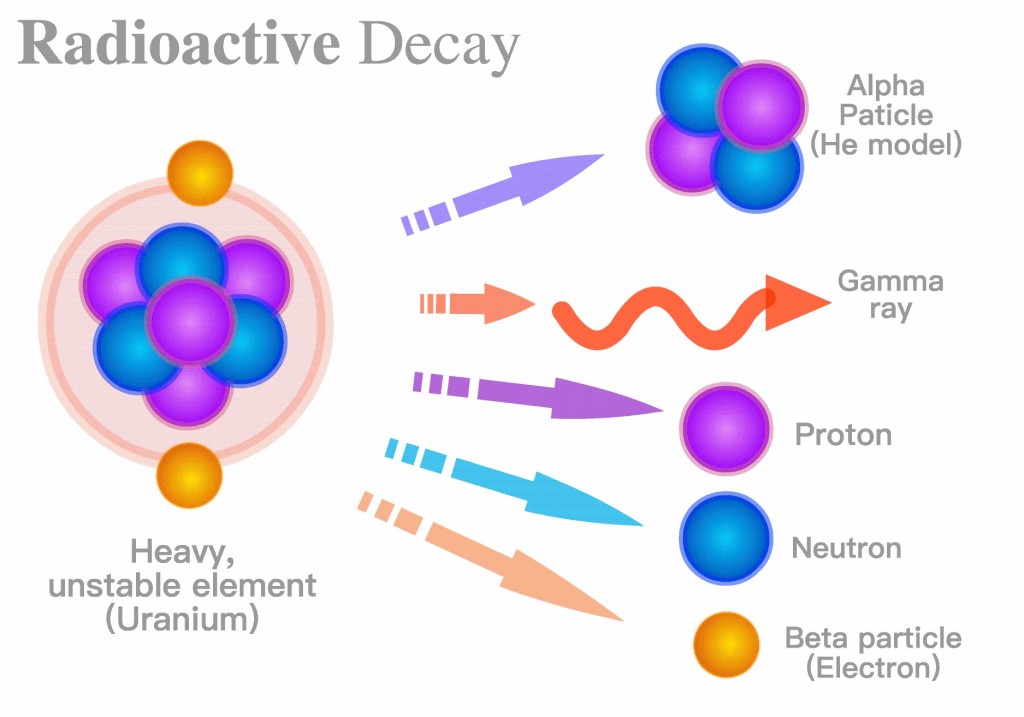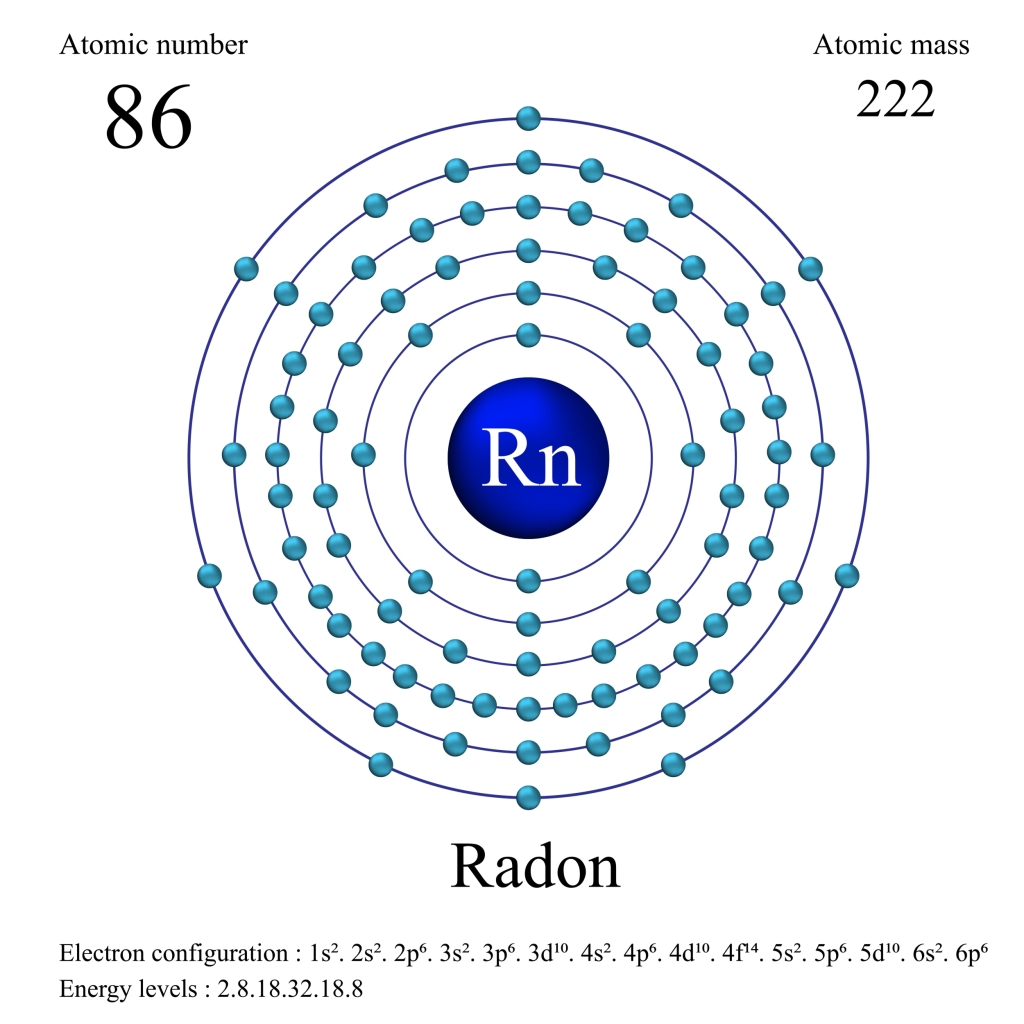Superfact 6 : Radon Represents our Largest Exposure to Ionizing Radiation
Radon represents our largest exposure to ionizing radiation. It is responsible for the majority of public exposure to harmful radiation. It is not the sun, the sky, nuclear weapons or nuclear power, or medical treatment, other terrestrial sources, it’s radon. Since we don’t talk much about the very deadly radiation emitted by the radon in our basements that may come as a surprise.
If a radioactive isotope has a long half-life, is that bad? I mean it will be around for a long time. Well, it is complicated. It is important to understand that if the decay rate for an isotope is very slow, in other words, it has a long half-life then it will be less radioactive. If the half-life is 1,000,000 shorter for an isotope X compared to an isotope Y (with a slower decay rate) than it is 1,000,000 more radioactive than isotope Y assuming their decay is of the same type. Short half life means more radioactivity. Long half-life means less radioactivity. The negative aspect of an isotope with a long half-life is that it will be around long, but the positive aspect is that it is less radioactive.

I should explain that isotopes mean that an atom can have a different number of neutrons. For example, carbon (coal) has a few common isotopes. C-12 has 6 protons and 6 neutrons, C-13 has 6 protons and 7 neutrons, C-14 has 6 protons and 8 neutrons. The isotope we are talking about when we talk about Radon is Radon-222. That is a really bad one. Radon-222 has a half life of 3.8 days which is 432 billion times shorter than Uranium-238, which has a half life of 4.5 billion years. So, if Radon-222 and Uranium-238 had the same type of decay (they don’t) Radon-222 would be 432 billion times more radioactive than Uranium-238.
Admittedly Uranium-238 isn’t very radioactive, you can safely hold it, but let’s take Plutonium-238, a famously radioactive isotope with a half-life of 87.7 years. Radon-222 has a half-life that is 8,424 times shorter yielding a decay rate and radiation intensity 8,424 times larger than Plutonium-238.
Radon

So, Radon-222 is indeed extremely radioactive. But that means it should disappear quickly. Unfortunately, the inside of the earth is constantly supplying more Radon-222 from the radioactive decay and fission occurring there. Nuclear fission (nuclear reactions) is happening inside the earth providing about half of earth’s heat and powering the movement of Earth’s continents and crust. Since Radon-222 is extremely radioactive and is being resupplied by our own planet it is a very big source of the radiation we are exposed to.
Among all the different kinds of sources it is the biggest one. Since Radon-222 is a natural phenomenon, and we focus on so many other types of other natural and unnatural radiation sources we tend to underestimate the problem. At least I did when we bought our first house. I was asking Radon, what Radon? I think it is a surprising and important fact and therefore a super fact.
Radon Exposure

The WHO estimates that radon exposure alone was estimated to have caused 84,000 deaths by lung cancer in one year. In 50 years, this would be 4.2 million deaths. The WHO predicted that the eventual total death toll from cancer related deaths from the worst nuclear disaster in history, Chernobyl, was 9,000, which is a lot less than 4.2 million. The numbers given by Greenpeace (which WHO does not accept) are up to a million and the Union of Concerned Scientists estimated 27,000.
Those numbers are all still smaller than the estimated deaths from Radon. Keep in mind that the Chernobyl reactor was a very dangerous reactor (RBMK) that lacked a containment shield, a reactor that could never be built in a western country. I can add that according to WHO the predicted future cancer deaths due to accumulated radiation exposures in the population living near Fukushima was between zero and a 100.
According to the United Nations Scientific Committee on the Effects of Atomic Radiation, more than 40% of the average annual human exposure to ionizing radiation is radon in the air. The other sources (all smaller) are cosmic background radiation, terrestrial radiation from the ground, radiation in food and water, exposure to radiation by medical treatment/exams, nuclear testing, Chernobyl, etc. According to former U.S. Surgeon General Richard H. Carmona, Radon is responsible for the majority of public exposure to ionizing radiation. Radon in our basements is indeed a very big deal compared to other radiation sources.


This is fascinating, Thomas. I enjoyed remembering about isotopes. Homes don’t really have basements here in SA, more so in Romania.
But my mind went right away to the life in the countryside (and not only) where, for centuries, people relied on their basements to make their food supply last longer.
in medieval Brasov, for example, a large cellar was dug somewhere near Council Square where cheeses, ale, bear too, grains were stored to keep them.safe from Ottoman invasions.
But life expectancy was so much lower then.
LikeLiked by 1 person
Yes, it must have been a problem, but one that people were unaware of. There were so many diseases back then and like you say people did not live long. I remember how surprised I was when I was told we had a significant radon problem in our basement in our first house. They said that spending a day in the basement was equivalent to smoking 12 cigarettes, and our 2-year-old toddler had been spending a lot of time there playing. I knew the Radon problem existed, and I also knew that radiation is an often highly exaggerated problem. So, when I heard 12 cigarettes per day I was surprised. It was a much bigger problem than I thought. We were told that our problem was pretty average for Wisconsin. There were places that were much worse. We got a pump that significantly reduced the Radon problem.
LikeLiked by 1 person
Oh, now that is something worrying. Glad you had it sorted on time.
LikeLiked by 1 person
Thank you Patricia. Yes a lot of people had these pumps where we lived.
LikeLiked by 1 person
Thanks for reinforcing all the testing I required before we bought our house over the summer. The basement was at a 10 I think so we had a radon mitigation system put in. I need to get David to re check the air down there. I also had the well water tested though the realtor didn’t think it was necessary. Thankfully the water tested zero for radon. I still won’t spend much time in the basement regardless.
LikeLike
Thank you JoAnna. All other radioactive sources are smaller than the quite large radon in the basement problem, and people don’t realize it. It is better to be safe than sorry and try to get rid of it.
LikeLiked by 1 person
You made no mention of X-rays. But this isn’t intended to be an encyclopedia.
Nuclear power is a good topic for another post.
LikeLiked by 1 person
X-rays are considered ionizing radiation (along with gamma rays, alpha particles, and beta particles, etc). You are right this is not an encyclopedia. However, hopefully I am providing enough links for those who want study the topic deeper. Yes Nuclear power is a good topic for another post.
LikeLike
The worst part of radon is not the ionizing radiation. It’s the fact that radon eventually becomes lead, which is a toxic heavy metal.
LikeLiked by 1 person
Well, it is a bit of an apples to oranges comparison. Radon-222 is generally considered more hazardous due to the direct inhalation of radioactive particles and the immediate risk of lung cancer. However, toxic lead poses a long term risk. Also remember that very minute trace amounts of radon-222 can do a lot of damage and from it you’ll end up with minute amounts of lead.
LikeLike